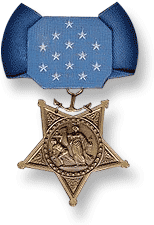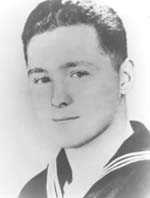Francis C. Hammond
| Francis C. Hammond | |
|---|---|
  Medal of Honor recipient Francis Hammond | |
| Born |
November 9, 1931 Alexandria, Virginia |
| Died |
March 27, 1953 (aged 21) Korea |
| Allegiance |
|
| Service/branch |
|
| Years of service | 1951 - 1953 |
| Rank | Hospitalman |
| Unit | 1st Battalion 5th Marines, 1st Marine Division |
| Battles/wars | Korean War |
| Awards |
Medal of Honor Purple Heart |
Francis Colton Hammond (November 9, 1931 – March 27, 1953) was a United States Navy Hospital Corpsman who served with a United States Marine Corps unit during the Korean War. He posthumously received the Medal of Honor for his actions during the night of March 26–27, 1953.
Born in Alexandria, Virginia, Hammond graduated from that city's George Washington High School in 1949.[1][2] He joined the Navy from Alexandria in 1951 and by March 26, 1953, was serving as a hospital corpsman with the 1st Marine Division in Korea. On that night, during a counterattack against an entrenched force, he exposed himself to intense hostile fire in order to treat wounded Marines, even after he had been wounded himself. When a relief unit arrived and his own unit was ordered to pull back, Hammond remained in the area, helping evacuate casualties and assisting the newly arrived corpsmen, until he was killed by mortar fire. For these actions, he was posthumously awarded the Medal of Honor.[1]
Hammond, aged 21 at his death, was buried at Arlington National Cemetery in Arlington County, Virginia.[3]
Medal of Honor citation
Hammond's official Medal of Honor citation reads:
For conspicuous gallantry and intrepidity at the risk of his life above and beyond the call of duty as a[n] HC serving with the 1st Marine Division in action against enemy aggressor forces on the night of 26–27 March 1953. After reaching an intermediate objective during a counterattack against a heavily entrenched and numerically superior hostile force occupying ground on a bitterly contested outpost far in advance of the main line of resistance, HC Hammond's platoon was subjected to a murderous barrage of hostile mortar and artillery fire, followed by a vicious assault by onrushing enemy troops. Resolutely advancing through the veritable curtain of fire to aid his stricken comrades, HC Hammond moved among the stalwart garrison of marines and, although critically wounded himself, valiantly continued to administer aid to the other wounded throughout an exhausting 4-hour period. When the unit was ordered to withdraw, he skillfully directed the evacuation of casualties and remained in the fire-swept area to assist the corpsmen of the relieving unit until he was struck by a round of enemy mortar fire and fell, mortally wounded. By his exceptional fortitude, inspiring initiative and self-sacrificing efforts, HC Hammond undoubtedly saved the lives of many marines. His great personal valor in the face of overwhelming odds enhances and sustains the finest traditions of the U.S. Naval Service. He gallantly gave his life for his country.[1]
Honors
A high school in Hammond's hometown of Alexandria, Virginia, was named in his honor in 1956. The upper grades of this school and Hammond's alma mater, George Washington High School, were consolidated into T. C. Williams High School[4] in 1971, while the lower grades eventually became Francis C. Hammond Middle School and George Washington Middle School.[2]
The frigate USS Francis Hammond (FF-1067) was named in his honor and commissioned on July 25, 1970.
See also
References
 This article incorporates public domain material from websites or documents of the United States Army Center of Military History.
This article incorporates public domain material from websites or documents of the United States Army Center of Military History.
- ↑ 1.0 1.1 1.2 "Medal of Honor recipients - Korean War". United States Army Center of Military History. August 3, 2009. Retrieved 2009-09-10.
- ↑ 2.0 2.1 Danforth, Austin (September 10, 2009). "Alumni Stress Over Future of Schools' Identity". Alexandria Times. Retrieved 2009-09-10.
- ↑ "Francis C. Hammond". Claim to Fame: Medal of Honor recipients. Find a Grave. Retrieved July 26, 2010.
- ↑ The consolidation of the two high schools created the dynamic for the movie Remember the Titans.
External links
- "Francis C. Hammond High School Alumni Association". Retrieved September 29, 2010.